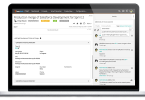It happens all the time in small-to-medium IT organizations: one person handles all the IT Operations (IT Ops) duties with occasional help from consultants.
But change happens. And organizations often grow large enough through acquisition, organic growth, or going public, such that the existing staff can no longer handle the IT Ops workload. When this happens, new IT problems becomes clear. You need to grow your IT Ops capabilities, and you need to do it quick.
If you’re in this situation, here are some personnel and technology suggestions on how you can reorganize your IT Ops function for growth.
Long or short-term pain points
The first thing you need to do is determine where you most need help and plan for that. You’ll need to separate this task into two areas of focus: short-term and long-term planning.
Once you’ve dealt with your short-term staff and infrastructure needs and upgrades, it’s time to look at the big picture and put the pieces in place for the long-term changes you’ll need for your IT Ops infrastructure. These changes can be defined by looking at potential staff changes and technology changes.
IT Ops roles for growth
In a recent BMC post, Joe Roush discussed the First Five IT Roles in New Organizations, where he discussed what IT positions a new organization should think about as they get started. Many of Joe’s suggestions also apply when expanding a one-person IT department due to growth. Using Joe’s list as a starting point, a growing IT Ops function should consider adding the following roles as it grows.
- IT Manager – Focused on technology brokering (implementation and purchasing), budgeting and paying bills, vendor management, efficiency, technology support, security, and risk management, as well as staff supervision. The IT Manager provides the strategic and operational management skills needed to support new and existing IT capabilities.
- Technology Specialist – Provide user help support for computing devices (desktop, laptop, and mobile devices) as well as Web and app-based support. This person would be responsible for day-to-day support, as well as machine configurations, software installation, patching, inventories, and machine security. The Technology Specialist insures the existing user infrastructure is up to date, secure, and in working order. This role is the beginning of a Help Desk that grows as the organization grows, and that can eventually evolve into a service desk.
- Systems Administrator (Sysadmin) – Sometimes combined with the Technology Specialist, the Systems Administrator role focuses on network management; server installation and management; and server application installation and management (including critical business apps, such as legacy and mobile production applications, EDI, and email). This role will evolve depending on how advanced the organization is in moving its network capabilities into the cloud, and the Sysadmin may also assist in cloud migration. If you’re beginning to implement a DevOps or Agile environment for faster application development, Sysadmins may also be responsible for monitoring application issues that application developers previously handled, such as data integrity, code evaluation to determine which pieces of code are causing issues, and response time evaluation (I previously wrote about how IT Ops is being called upon to assume certain application duties in DevOps and Agile software environments in this post).
- Social Media, Mobile, and Website Specialist – Responsible for the organization’s social media presence, as well as its public facing website. Although this position is frequently assigned to the IT organization, it’s just as common to have these roles reside in line-of-business functions, where IT supports the configuration and management of the social media, mobile, and Web platforms, and line of business personnel support content generation and presentation.
- Compliance and auditing administration – When a company goes public, it’s usually accompanied by compliance and auditing requirements. This position defines compliance and auditing event and logging capture, as well as reporting needs. The compliance and auditing role might be combined with the IT Manager or Sysadmin position to handle all issues associated with achieving and maintaining compliance.
- Other specialty positions – As the organization’s needs change, there may be other positions that need filling. These positions may involve IT functions that are specifically designed to serve a business-related purpose, security implementations, or other work that is currently being performed by consultants that you now want to bring in-house.
Technologies to consider adding
Once you’ve looked at these different IT Ops role and determined how best to fill them (in-house, consultant, or hosting), it’s time to look at and think about the various technologies you’ll need to evaluate as your organization’s IT Ops structure grows. Some of the different technologies you may want to evaluate include:
- Cloud services – Moving servers, infrastructures, applications, backups, and other IT Ops functions to a cloud provider. Migrating IT Ops infrastructure from dedicated Data Centers to the cloud can decrease or even eliminate internal Data Center footprints and costs, provide more availability, and free up IT departmental time to focus on revenue enhancing projects.
- Data Center automation – Automating common Data Center IT Ops functions so that dedicated personnel don’t have to attend to them. Many Data Center functions can be automated, including Data Center management using AIOps; and automated scheduling for items such as backups, downloads and uploads, and application processing. Check out these linked articles for more information on Data Center automation and Artificial Intelligence for IT Operations (AIOps).
- Monitoring – Implementing automated solutions for monitoring infrastructure, application performance, hardware, event logs, storage, and other IT Ops functions. Click here to see a complete list of BMC articles on implementing and using monitoring software in an IT Ops environment.
- Service desk implementation – Where you’re ready to move beyond providing basic Help Desk functions, you may want to consider evolving your Help Desk into a Service Desk. A Service Desk provides all the same functions as a Help Desk, but it’s centered around business needs and IT Service Management (ITSM) practices rather than only providing the break/fix activities, basic provisioning, and deployment of new technologies and services that the Help Desk is centered around. A Service Desk provides an IT service catalogue of available IT services, incident management, hardware and software ordering and provisioning, event management, problem management, and other ITSM capabilities. Click here for a description of what a Service Desk provides that a Help Desk doesn’t provide.
These are a few of the staffing needs and technologies that can help growing organizations maintain better control over their infrastructure.
These postings are my own and do not necessarily represent BMC's position, strategies, or opinion.
See an error or have a suggestion? Please let us know by emailing blogs@bmc.com.






